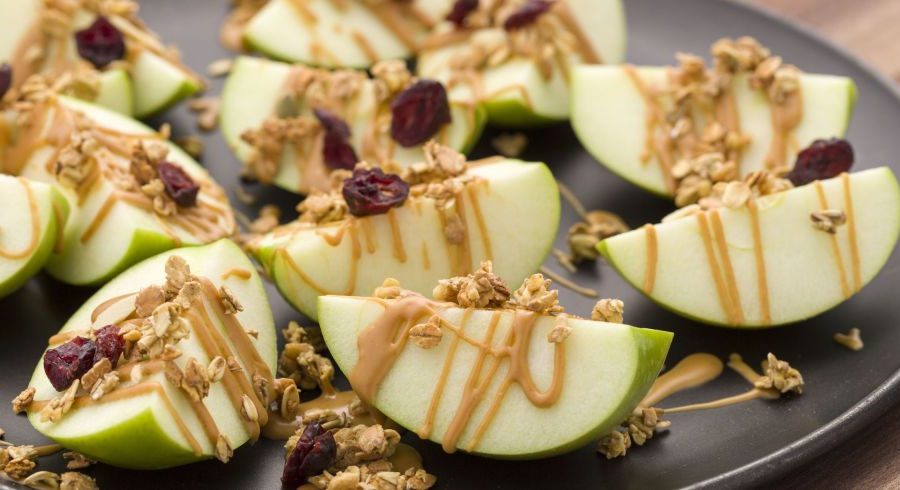By the time you’re old enough to walk, your parents will probably have put serious effort into teaching you to understand the difference between what’s safe to eat and what’s not. We have symbols on packages to tell us whether certain foods are poisonous, and rules and regulations for other foods like chicken and beer that try to help us understand how to handle and cook them safely so that no one gets sick from bacteria. After all, no one wants to eat poison. Except for a few times when we’ve gone ahead and found a way to do just that, avoiding the danger of snacking on delicious food just because we can.
10. Just 2 teaspoons of nutmeg can cause toxic effects

Every fall, a pumpkin spice craze sweeps the Western world, adding flavoring to coffee, cakes, cereal, and even cat litter. Real spice mix has nothing to do with pumpkin, although it is a necessary addition to any pumpkin pie recipe and includes cinnamon, ginger, cloves, and nutmeg. Nutmeg, in particular, is one of the most flavorful ingredients, which really gives the mixture its iconic aroma and flavor. But nutmeg on its own is not as safe as most people think.
Nutmeg can actually cause intoxication , and, in fact, the spice has been touted as a kind of all-natural, low-budget way to get high for years. Using nutmeg as a medicine can lead to acute psychotic symptoms, as well as dizziness, hallucinations, seizures, organ failure and, in some cases, when combined with other drugs, to death.
The toxic compound in nutmeg is called myristicin, and it affects your body in much the same way as mescaline. As little as 10 mg, or 2 teaspoons, of nutmeg can cause symptoms of myristicin toxicity.
9. Pufferfish is not poisonous by nature.

Fugu, or puffer fish, was a notorious food that most of us had heard of, even if we had never seen it in person. There's even an old episode "The Simpsons" 1991 , in which Homer eats a potentially fatal dish.
The toxicity of the puffer fish comes from what is called tetrodotoxin , which is concentrated in the liver of fish. If you consume the toxin, it blocks the nerve cells in your body. As a result, your muscles can no longer contract. A mild case may cause numbness and possibly difficulty breathing. But in severe cases, when your muscles cannot contract at all, your lungs and heart cannot function, and you die.
The thing is, the pufferfish toxin is not a natural part of the fish. It is from bacteria that live in the same habitat as the fish they eat. You can get farmed pufferfish that are 100% non-toxic , because the fish is never exposed to dangerous bacteria. But otherwise, you can always try eating traditional fugu prepared by a very experienced chef who has been trained to cook the fish while removing the poison. They do a decent job, and, It seems like someone dies from this every year only a handful of people , so perhaps the odds will be in your favor.
8. Most species of wild almonds are poisonous.

In California alone, the almond industry is worth 11 billion dollars, which is a testament to the fact that people are truly crazy about these nuts. Almond milk has become a major player in the almond world, but the nuts themselves are still extremely popular and find wide use in snacks, cereal, chocolate bars, and more. Somewhat ironically, they are only edible by accident.
The researchers sequenced genome almonds back in 2019 and determined that the modern delicious almond is a genetic mutation. Old-school almonds were toxic across the board — and even today, if you try to eat a wild almond, it will taste bitter and potentially deadly if you eat about 50 pieces There is enough cyanide to kill a healthy adult, and more than enough to kill a child.
A mutation in today's delicious almond disabled the tree's ability to produce toxic compounds. It was a fluke that farmers seized and turned into an industry.
7. Poisonous potatoes can be safely eaten with clay sauce

Potatoes have a decidedly strange history. First grown in Peruvian Andes Thousands of years ago, the tubers arrived in Europe in the 1500s, where they were viewed with distrust. For some time people thought they cause leprosy . Of course, they were soon accepted, became widespread, and are perhaps today one of the most popular and important foods in the world. But that is today.
If you go back to Peru, there is a tradition there potatoes with clay They make a clay sauce to coat the potatoes to make them more palatable, as strange as that sounds. The clay itself is not palatable and tastes like salty mud. But some local varieties of potatoes are very bitter, and the clay sauce they are eaten with neutralizes this.
Besides making the potatoes more palatable, the clay served another purpose: neutralizing toxins. Wild potatoes contained compounds called solanine and tomatine . The toxins bind to the clay and pass through the digestive system. And although locals have managed to grow non-toxic potatoes, some strains still exist and are still served with clay sauce to make them edible.
6. Cashews in shell are poisonous

If you like peanuts, you can usually find them shelled or unshelled in stores everywhere. Pistachios are often sold in their shells, but you can buy them shelled, too. And walnuts and almonds are usually shelled, but especially during the holidays, you can make a nutcracker and do the job yourself. Almost any nut you want to eat can be bought in its shell, except cashews. That's because shelled cashews are poisonous. And you don't have to eat the shell to experience the effects. The oil in the cashew shell can cause rash and blisters .
Cashews belong to the same family as poison ivy and poison sumac, so they produce an irritating oil. Although it's rare, eating cashews that you handle yourself and that haven't been properly roasted or steamed to destroy the oil can lead to hospitalization from things like these, like dermatitis If a person had a sensitivity to oil and ate too many cashews, the reaction could have been fatal .
5. Greenland shark meat must be fermented to be edible.
Most of us will never see a Greenland shark, let alone eat one, but you know that if there's anything in the world with a face, someone else has tried to eat it. The problem with trying to eat a Greenland shark, a slow-moving, surprisingly long-lived ocean dweller, is that their meat is toxic.
Greenland shark meat contains something called trimethylamine oxide, which turns into trimethylamine . Trimethylamine consumption causes effects similar to alcohol intoxication, which may begin with nausea and vomiting, progressing to the point of blindness and, finally, lead to death.
Humans cannot eat the Greenland shark, so the meat must be processed. In Iceland, the meat is fermented for 6 months or dried. Dried shark is fed to sled dogs, but the fermented dish, known as hakarl, is an Icelandic delicacy. The taste is described as fishy or rotten with aftertaste of urine . Not the best by the sound of it, but at least it won't kill.
4. Cassava root contains cyanide.
Cassava is the source of tapioca, and its large tuberous roots are widely consumed throughout the world. Although cassava is not as abundant in North America as in other countries, African countries produce it annually billions of tons root, and in many of them it is one of the main crops. The root can be consumed in many forms, including flour, but it must be processed properly. Raw cassava can be fatal.
Raw cassava contains cyanogenic glycosides. If you eat them, they can turn into cyanide in your body. The best way to prevent this is to soak cassava root in water, which breaks down these dangerous compounds. Traditionally, the root is also prepared in this way.
There have been many documented cases of a disease called konzo in Africa that causes paralysis among other symptoms associated with cassava, partly because the tradition of soaking the roots for a week in a stream sometimes has to be skipped due to many factors, including war, and people cannot rely on having the time and stability to properly prepare cassava.
3. Just 4 or 5 raw beans can cause poisoning

Red beans are one of the most popular legumes in the world. Only in the United States do farmers produce their more 86,000 metric tons . They are usually sold either dried in bags, where you have to soak them for a few hours before you can eat them, or in cans, where you can eat them right away. But you rarely see raw red beans, and for good reason — they are highly toxic.
Red beans contain compounds that called lectins . Four or five raw beans can cause toxic effects, the symptoms of which get worse the more you eat. That's why if you cook raw beans, you need to follow the correct cooking procedures and make sure they reach a temperature that can kill the toxic compounds. Beans cooked in a slow cooker never get hot enough.
A particularly dangerous lectin has a cumbersome name phytohemagglutinin Raw beans can contain between 20,000 and 70,000 units of this toxin, while cooked beans may contain only 200 units.
2. The ackee fruit is deadly until it ripens naturally.
Ackee and salted fish - national dish of jamaica , and if you've never tried it before, find a good Jamaican restaurant and try it because it can be delicious. But you definitely want to get someone who knows what they're doing to make it, as the ackee fruit is poisonous and results in something sinister called Jamaican vomiting sickness .
As the name suggests, bad aki can cause vomiting, as well as abdominal pain, cramps and death . If the fruit is ripe and opens on its own, it is ready to eat and is perfect. If it is unripe, beware, that is where the trouble comes from.
The fruit must ripen on the tree and turn red, then open naturally. The edible part of the fruit contains a compound called hypoglycin . It is extremely toxic until the fruit is ripe and the compound naturally decreases in sunlight. Otherwise, it causes severe hypoglycemia, which is low blood sugar. It can be treated with dextrose if caught in time.
1. Distillation of psychotropic compounds from mushrooms in reindeer urine

There are three kinds of mushrooms in the world, at least in terms of how a hungry person can use them. There are the safe, delicious, non-toxic mushrooms that you can eat and enjoy throughout the day. There are the relatively safe psychoactive mushrooms that will take you on a hell of a trip with hallucinations, but you'll still survive the experience. And then there are the mushrooms that will kill you, some much more quickly than others.
The mushroom known as the fly agaric is a bit of a food safety gamble. It can be classified as all three types of mushrooms, which doesn't make sense at first until you consider how people ate it.
With its red cap and white spots, it's a very recognizable mushroom, but it's not something you can eat on its own. Or at least you shouldn't. Although this hallucinogenic compound is one of the most powerful in the mushroom kingdom, eating it in large quantities can cause nausea, convulsions and coma . It also looks almost identical to a handful of other mushrooms that are incredibly deadly, and even experts It is difficult to tell them apart. So how do people use it safely?
The answer to this question lies in the reindeer. Mushrooms grow in the far north, and reindeer are known to eat them often and safe. Then the reindeer herderscollect urine stoned reindeer and distilled to produce the effects of the hallucinogenic compounds without any of the other dangerous toxins that were filtered out by the reindeer.













Оставить Комментарий